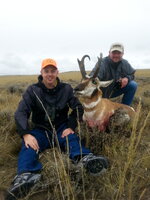I think most of us make a mistake over and over again. We go on a hunt, but don’t make the effort to think critically about 1 thing we learned and will do different next time.
Think about it, how often do magazines write about a hunt, but fail to single out an action item to change in the future? Just 1 thing, maybe something you learned about antelope behavior, your rifle setup, clothing, camping system. We can consume all the information we want, but if we don’t change anything, did it really do us any good?
I’d like to start a series of discussions to get us in the habit of reviewing our hunt, and share highlights about the 1 thing we learned on a particular topic. To start, 1 thing I learned about hunting antelope in Wyoming and Montana is that wind can impact your trip unlike any other hunt you’ve been on. Even though I grew up in central Oregon where there are plenty of windfarms, I’ve never seen anything like what you find in the above states. On my first trip to Wyoming 6 years ago, the guy I was with told me to hold on the tail of the antelope I was shooting at 340 yards away. He was right, that wind had to be going 30 mph and the call was perfect. 3 years ago I got to hunt with my brother in central Montana, and half the trip was spent in the hotel room because the wind was blowing too hard to hunt. I didn’t even know that was a thing, but we tried driving around and all the animals were hunkered down out of sight. From these experiences I learned to get way better at reading wind, and build extra days into the trip to account for extreme weather I’m just not used to.
So how about you, what is one thing you have learned about antelope? (include pictures if possible)

Think about it, how often do magazines write about a hunt, but fail to single out an action item to change in the future? Just 1 thing, maybe something you learned about antelope behavior, your rifle setup, clothing, camping system. We can consume all the information we want, but if we don’t change anything, did it really do us any good?
I’d like to start a series of discussions to get us in the habit of reviewing our hunt, and share highlights about the 1 thing we learned on a particular topic. To start, 1 thing I learned about hunting antelope in Wyoming and Montana is that wind can impact your trip unlike any other hunt you’ve been on. Even though I grew up in central Oregon where there are plenty of windfarms, I’ve never seen anything like what you find in the above states. On my first trip to Wyoming 6 years ago, the guy I was with told me to hold on the tail of the antelope I was shooting at 340 yards away. He was right, that wind had to be going 30 mph and the call was perfect. 3 years ago I got to hunt with my brother in central Montana, and half the trip was spent in the hotel room because the wind was blowing too hard to hunt. I didn’t even know that was a thing, but we tried driving around and all the animals were hunkered down out of sight. From these experiences I learned to get way better at reading wind, and build extra days into the trip to account for extreme weather I’m just not used to.
So how about you, what is one thing you have learned about antelope? (include pictures if possible)

